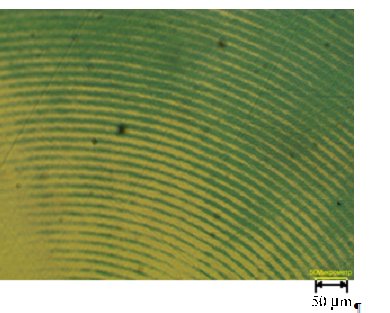Here we report the first experimental realization of a nondiffracting Bessel beam technique for the controlled deposition of metallic sodium on the surface of a sapphire substrate, thus forming a micrometric scale annular metal grating.
Nondiffracting optics is an actively developing area of research in the field of optical beams and applications. The diffraction-free beams have the property of conserving their transverse intensity distribution during propagation in free space. The zeroth-order Bessel beam is a particular case of diffraction-free beams. The profile of the Bessel beam is a set of concentric rings. The envelope of the intensity profile of the Bessel beam decreases inversely proportionally to the radial distance. The Bessel beam can be used for optical microstructuring of metal films. The nondiffracting character of the Bessel beam provides robustness against longitudinal shifts of the substrate and high contrast of metallic microstructures. A number of practical ways to generate Bessel beams have been suggested, including the use of ring apertures, Fabry–Perot interferometers, programmable phase modulators based on the phase-imprinting technique, holographic diffractive elements, and nonlinear generation of conical emission. One of the ways to form Bessel beams is the use of an optical element – axicon.

Experiments have been performed with a cylindrical 6 cm long Pyrex cell with sapphire windows of 3 cm diameter. The cell was evacuated, filled with sodium and sealed off. At the beginning of each experiment, the front window was cleared of sodium by heating. Subsequently, when the front window cooled to room temperature (20 °C), it was illuminated and the temperature of the rare part of the cell where the metallic sodium resides was raised to 80 °C, corresponding to atomic density of ~109 cm−3.
The illumination of the front window of the cell by the Bessel beam was performed as follows. The Na cell was placed in the Bessel zone of a beam with 2 W/cm2 intensity for 30 min. This provides a nonuniform spatial distribution of the illumination intensity over the sapphire window surface and the optical control of Na atoms deposition on the sapphire substrate. The growth of the metal film in nonilluminated areas of the sapphire substrate provides the formation of annular microstructures induced by the Bessel beam. After 30 min of laser-controlled deposition, the substrates were examined by optical microscopy. A fragment of the optical microscope image of Na deposits is shown in the Figure. The obtained metal deposits form sharp-cut circles with a pitch of 15 μm, coincident with the dark rings of the Bessel beam. Reduction of the laser power leads to the build up of the continuous metal film over the whole substrate. Taking into account the number density of the sodium vapour, the average thermal velocity of sodium atoms, and assuming a sticking probability of 0.3, the amount of sodium atoms arrived at the surface in 30 min may be estimated as 103 nm−2 for a deposition rate 0.02 nm/s.